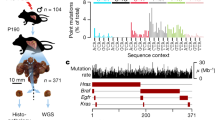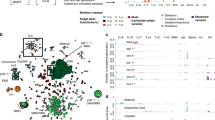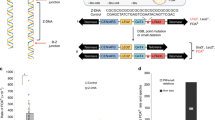Abstract
IT has been repeatedly proposed that neoplastic cells arise from genetically heterogeneous populations. If so, carcinogens should induce genetically abnormal cells by increasing the frequency of mutations. The mutagenic capacity of carcinogens has been examined in Drosophila1,2, Neurospora3, yeast4, transforming DNA5, and template activity of DNA6. Until recently, however, a study of chromatid aberrations and structural and numerical chromosome anomalies was the only way to examine the mutagenic effect of carcinogens on the tissues of complex organisms in which they induce neoplastic transformation7,8. The disadvantage of this method lies in its restriction to numerical and structural chromosome alterations which represent only a part of the wide spectrum of all possible genetic changes elicited by a mutagen. In the work to be described here we have used unscheduled DNA synthesis as an indicator of DNA lesions9–11. Derivatives of 4-nitroquinoline 1-oxide (4NQO) and related compounds were chosen because of their wide variance in oncogenic capacity12–15. Cultured Syrian hamster cells of the first to third passage were used. These cells are susceptible to neoplastic transformation in vivo12–21 and in vitro22–23 after exposure to the carcinogens used. Moreover, they respond to 4NQO induced DNA lesions with a readily analysed DNA repair synthesis24.
This is a preview of subscription content, access via your institution
Access options
Subscribe to this journal
Receive 51 print issues and online access
$199.00 per year
only $3.90 per issue
Buy this article
- Purchase on Springer Link
- Instant access to full article PDF
Prices may be subject to local taxes which are calculated during checkout
Similar content being viewed by others
References
Demerec, M., Science, 105, 634 (1947).
Fahmy, O. G., and Fahmy, M. J., Cancer Res., 30, 195 (1970).
Tatum, E. L., Ann. NY Acad. Sci., 49, 87 (1947).
Nagai, S., Mutation Res., 7, 333 (1969).
Maher, V. M., Miller, E. C., Miller, J. A., and Szybalski, W., Mol. Pharmacol., 4, 411 (1968).
Tata, M., Tada, M., and Takahashi, T., Twenty-third Ann. Symp. Fund. Cancer Res., 523, (1969).
Maini, M., and Stich, H. F., J. Nat. Cancer Inst., 26, 1413 (1961).
Joneja, M., and Stich, H. F., Exp. Cell Res., 31, 220 (1963).
Rasmussen, R. E., and Painter, R. B., J. Cell Biol., 29, 11 (1966).
Cleaver, J. E., Nature, 218, 652 (1968).
Cleaver, J. E., Radiat. Res., 37, 334 (1969).
Kawazoe, Y., Araki, M., Aoki, K., and Nakahara, W., Biochem. Pharmacol., 16, 631 (1967).
Nakahara, W., Fukuoka, F., and Sugimura, T., Gann, 48, 129 (1957).
Nakahara, W., Fukuoka, F., and Sakai, S., Gann, 49, 33 (1958).
Kawazoe, Y., Araki, M., and Nakahara, W., Chem. Pharm. Bull., 17, 544 (1969).
Hoshino, H., Kawazoe, Y., and Fukuoka, F., Gann, 60, 523 (1969).
Kawachi, T., Hirate, Y., and Sugimura, T., Gann, 56, 415 (1965).
Shirasu, Y., Gann, 54, 487 (1963).
Endo, H., and Kume, F., Gann, 54, 443 (1963).
Saneyoshi, M., and Ikehara, M., Chem. Pharm. Bull. (Tokyo), 16, 1390 (1968).
Mori, K., Ohta, A., Murakami, T., Tamura, M., and Kondo, M., Gann, 60, 663 (1969).
Sato, H., and Kuorki, T., Proc. Jap. Acad., 42, 1211 (1966).
Kamahora, J., and Kakunaga, T., Proc. Jap. Acad., 42, 1079 (1966).
Stich, H. F., and San, R. H. C., Mutation Res., 10, 389 (1970).
Sugimura, T., Otake, H., and Matsushima, T., Nature, 218, 392 (1968).
Horikawa, M., Nikaido, O., and Suguhara, T., Exp. Cell Res., 55, 65 (1969).
Freed, J. J., and Schatz, S. A., Exp. Cell Res., 55, 393 (1969).
Druckrey, H., and Kumpfmuller, K. Z., Naturforsch., 3, 254 (1948).
Nakahara, W., Prog. Exp. Tumour Res., 2, 158 (1961).
Witkin, E. M., Ann. Rev. Genetics, 3, 525 (1969).
Setlow, R. B., Prog. Nucl. Acid. Res. Mol. Biol., 8, 257 (1968).
Author information
Authors and Affiliations
Rights and permissions
About this article
Cite this article
STICH, H., SAN, R. & KAWAZOE, Y. DNA Repair Synthesis in Mammalian Cells exposed to a Series of Oncogenic and Non-Oncogenic Derivatives of 4-Nitroquinoline 1-Oxide. Nature 229, 416–419 (1971). https://doi.org/10.1038/229416a0
Received:
Issue Date:
DOI: https://doi.org/10.1038/229416a0
This article is cited by
-
The genotoxicity of trenbolone, a synthetic steroid
Archives of Toxicology (1988)
-
Detection of chemical carcinogens by assay of unscheduled DNA synthesis in rat tracheal epithelium in short-term organ culture
Journal of Cancer Research and Clinical Oncology (1981)
-
The combined action of chemical carcinogens on DNA repair in human cells
Radiation and Environmental Biophysics (1980)
-
DNA damage and repair induced by diazoacetyl derivatives of amino acids with different mechanism of cytotoxicity. Correlations with mutagenicity and carcinogenicity
Journal of Cancer Research and Clinical Oncology (1979)
Comments
By submitting a comment you agree to abide by our Terms and Community Guidelines. If you find something abusive or that does not comply with our terms or guidelines please flag it as inappropriate.



